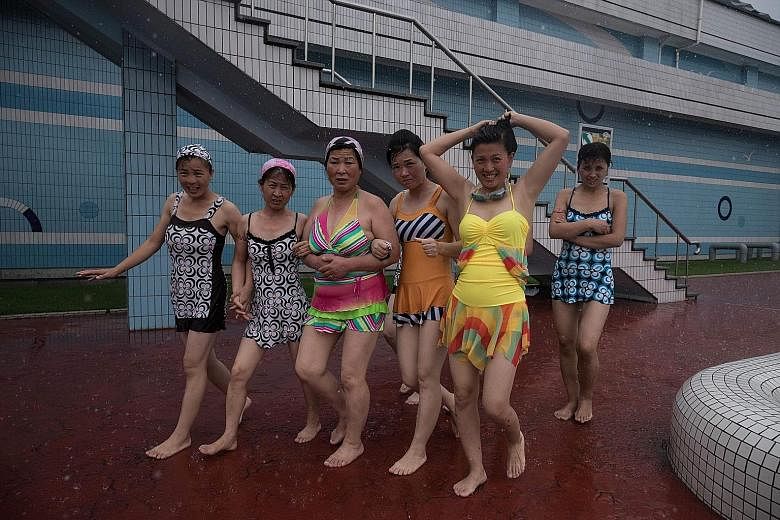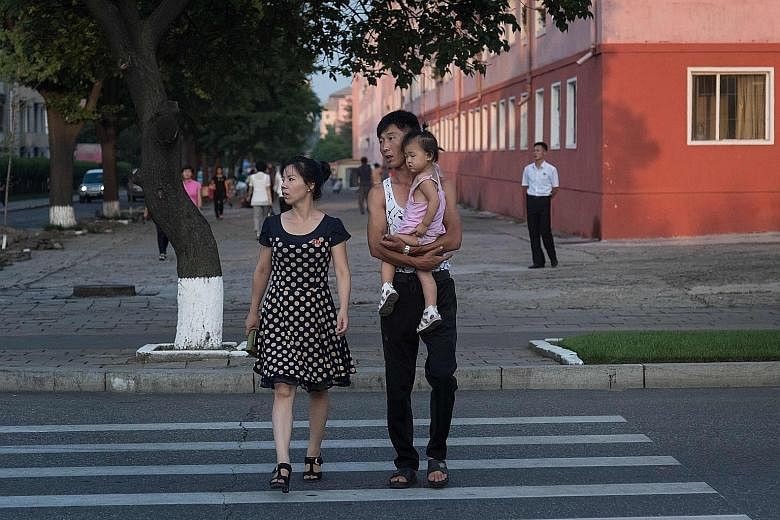NEW YORK • Say "fashion in North Korea" to anyone and you are liable to get a snort in return and a snarky comment about the hair of Kim Jong Un, the 33-year-old leader.
It is true that most North Koreans are too poor and too hungry to think much about clothing in what may be the most authoritarian, least accessible state on earth, run by a scion of a dynasty that has ruled with complete control since an armistice ended the Korean War in 1953.
And it is easy to think of North Korea as an one-dimensional place. Just look at the huge demonstrations that are the most common public image of local life, invariably showing thousands of citizens, some in military garb, some in Korean cultural dress, still others in various uniforms, all performing in lock step.
Yet, Pyongyang, the capital, where I spent five days earlier this autumn as part of a trip with The New York Times editorial board, has more nuance, texture and colour than I expected. While it is important not to over-analyse a first trip to any country, I was struck by the fact that contrary to the blistering official propaganda, not all North Koreans are eager to bomb the United States. People will fight for their country, absolutely, they told me, but some insisted they harbour no ill will towards Americans and would prefer to live in peace.
Details of dressing that I saw and of the life in general reinforced suspicions that the desire for personal expression has not been totally snuffed out.
In Pyongyang, where the party elite dominate and some have more chance of rubbing shoulders with foreigners, either in the city or on trips to China or Europe, I was surprised by the stiletto high heels, a staple of the attractive young women who are overwhelmingly favoured for jobs as waitresses, singers and virtually any responsibility that has public visibility and requires long hours on one's feet.
Our junior minder, Ms Hong Hye Gyong, a 20something intern with the Foreign Ministry, walked kilometres in her heels - they looked to be about three inches - without complaint as our group traipsed the uneven city sidewalks en route to a gift store and amusement park.
She favoured a tailored black dress as her work outfit topped by a short fitted jacket, including one in bright red. Indeed, though clothing tends to the black and grey, apparently pink, purple and white are becoming more popular. Even so, make-up tends to be minimal or non-existent and people generally dress conservatively, even at amusement parks and dolphin shows; there was no sign of blue jeans, thought to be a sign of Western decadence. On the other hand, skirts often ride slightly above the knee.
The sartorial fresh air is often attributed to Kim, who is not much of a fashion plate, but reportedly expanded the importing of luxury goods after coming to power in 2012, or at least he did before the United Nations tightened sanctions. His wife Ri Sol Ju, who has a fondness for tailored form-fitting dresses, is seen as something of a style icon.
While a number of young women carried fashionable purses, we were not permitted to visit any department stores, so examining the provenance of items was impossible. Chinese counterfeits are reportedly plentiful. Most people wear clothes made of vynalon, a synthetic fibre produced in North Korea since the 1950s that is considered a symbol of the country's ideology of self-reliance, but has the disadvantage of being stiff and difficult to dye.
The senior Foreign Ministry officials who were our interlocutors - all men - would have easily blended into the crowd in New York. One wore a blue blazer and blue trousers with a white button-down shirt; another, a black-and-white chequered jacket, black pants and a white shirt; the third, a black suit, white shirt and blue tie with white polka dots.
Despite such evidence of what, for a repressive country, constitutes fashion experimentation, uniforms were ubiquitous. And not just for those in the military, where hats with tops as big as small pizza pans and sharply pressed loosely fitted brown pants are worn by men and women officers.
Women directed traffic on main city streets and took tickets in the subway in prim blue suits (the colour varied with the job), short white socks and sensible chunky pumps. Those waiting on tables in restaurants were more apt to wear matching dresses such as black and orange sheaths, while silk factory workers toiled away in shapeless housedresses and aprons, with kerchiefs on their heads; daycare workers wore white dresses and accordion hats a la Western nurses of yore.
Pins, required to be worn by all adults, feature either Kim Il Sung, North Korea's founder, his son Kim Jong Il, or both. People told us it did not matter which one you wore as long as it was on the lapel over the heart in full view.
For students of all ages, the routine was white shirts, red kerchiefs and navy on the bottom: pants for the boys, skirts for the girls. But even here, individuality is creeping in. Some children wore white blouses with ruffles instead of plain long-sleeved white shirts, while others added diverse accessories - pink backpacks, red-and-black striped socks, black platform shoes, an orange/black and white athletic jacket. On the sports field, the boys looked liked athletes anywhere, in their jerseys and ersatz polo shirts.
It was the toddlers at daycare, however, who caught my eye. In unmatching T-shirts and pull-up pants, they were a riot of pattern and hue, wearing a yellow shirt with purple pants, a multi-striped shirt with print bottoms or a yellow and pink top, pink bottoms and blue and white socks. As far as fashion goes, that youngest generation made the most radical statement.
NYTIMES


